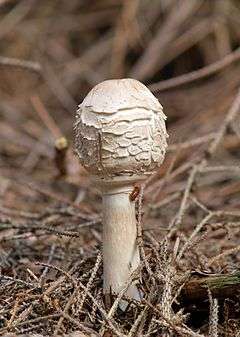Chlorophyllum
Chlorophyllum is a genus of large agarics similar in appearance to the true parasol mushroom. Chlorophyllum was originally coined in 1898, a time when spore color was the deciding factor for differentiating genera. It was termed in order to describe the poisonous green-spored C. molybdites which shared many characteristics of the mushrooms within the genus Lepiota but lacked the all important white spores. The name derives from Greek Chloro meaning green and phyllo meaning leaf (or gill in this case). It remained as a monotypic genus until recently when modern DNA analyses concluded that many of the mushrooms contained in the genus Macrolepiota actually had more in common genetically with the Chlorophyllum molybdites than with the other members of the Macrolepiota.[2] The genus has a widespread distribution, with many species found in tropical regions. The best known members are the edible shaggy parasol, a name applied to three very similar species Chlorophyllum rhacodes, C. olivieri and C. brunneum, and the poisonous C. molybdites, which is widespread in subtropical regions around the world.
| Chlorophyllum | |
|---|---|
 | |
| Shaggy parasol | |
| Scientific classification | |
| Kingdom: | |
| Division: | |
| Class: | |
| Order: | |
| Family: | |
| Genus: | Chlorophyllum |
| Type species | |
| Chlorophyllum esculentum Massee (1898) | |
List of species
As of July 2019, the nomenclatural database Index Fungorum lists 28 species in the genus.[3]
- C. abruptibulbum
- C. africanum
- C. agaricoides
- C. alborubescens
- C. arizonicum
- C. bharatense
- C. brunneum
- C. demangei
- C. globosum
- C. hortense
- C. humei
- C. levantinum
- C. lusitanicum
- C. madagascariense
- C. mammillatum
- C. molybdites
- C. morganii
- C. neomastoideum
- C. nothorachodes
- C. olivieri
- C. paleotropicum
- C. pseudoglobosum
- C. rhacodes
- C. shimogaense
- C. sphaerosporum
- C. subfulvidiscum
- C. subrhacodes
- C. subrhacodes
- C. venenatum
See also
| Wikispecies has information related to Chlorophyllum |
| Wikimedia Commons has media related to Chlorophyllum. |
References
- Massee, George Edward (1898). "Fungi exotici, I". Bulletin of Miscellaneous Informations of the Royal Botanical Gardens Kew: 113–36.
- Vellinga, Else. "Archived copy" (PDF). Archived from the original (PDF) on 2008-07-20. Retrieved 2010-11-24.CS1 maint: archived copy as title (link), Volume 16, Number 2, Fall 2006.
- Kirk PM. "Species Fungorum (version 30th January 2015). In: Species 2000 & ITIS Catalogue of Life". Retrieved 2015-02-13.